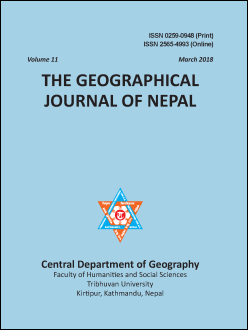Policies and Institutions for Disaster Risk Management in Nepal: A Review
DOI:
https://doi.org/10.3126/gjn.v11i0.19546Keywords:
Nepal, Disaster, Legislation, Policy, Institution, Strengths, ConstraintsAbstract
This paper is a review of policies for disaster risk management in Nepal and discusses the strengths, gaps and constraints of the same. Institutional and Legislative Systems (ILS) approach has been adopted focusing on three aspects: i) legal and regulatory frameworks, ii) policies and programs, and iii) organizational/institutional set-up. This paper concludes that newly endorsed Disaster Risk Reduction and Management Act (2017) can be a milestone in disaster management of Nepal not only because it has replaced about 40 years old Natural Calamity (Relief) Act, 1982 but also for the first time, it saw disaster risk management as an process focusing on different stages of disaster management cycles, preparedness, response and rehabilitation and mitigation. The provision of well-structured functional institutional set-up from the centre to local level can have positive outcome in disaster management. However, it overlooks significant aspect, such as the declaration of disaster-prone zones limiting the right of provincial disaster management committee only for recommendation to the Government of Nepal. Most of policies, strategies and legislations focused on some specific disasters such as flood, landslide, earthquake and GLOF/avalanches at national level paying less emphasis to the local level. Even now, most of the policy interventions towards different cycles of disaster risk management have laid emphasis on preparedness and response rather than to rehabilitation and mitigation. The conflicting provisions in Acts such as Water Resource Act (1992) and Building Act (1998) with Local Government Operation Act (2017) have made overlapping of their roles and responsibilities. So, the policy formulation and institutional set-up needs to be complemented by the ability and competence to operationalize the intent of the relevant acts and policies at all levels of government.
The Geographical Journal of Nepal
Vol. 11: 1-24, 2018
Downloads
Downloads
Published
How to Cite
Issue
Section
License
© Authors




